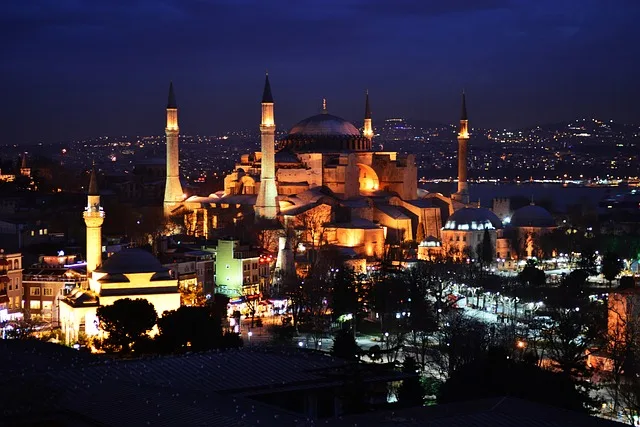Originally built as a cathedral in 537 AD, Aya Sophia was the center of Orthodox Christianity for nearly a thousand years. Can you picture the grand ceremonies that took place within its walls? The air thick with incense, the sound of hymns reverberating off the marble, and the sight of worshippers gathered in awe. It’s a place where history and spirituality intertwine, creating an atmosphere that’s both reverent and awe-inspiring.
But the Aya Sophia isn’t just about its past; it’s a living symbol of resilience. After being converted into a mosque in the 15th century, it embraced a new chapter while still honoring its Christian roots. This blend of cultures is like a beautiful tapestry, woven with threads of faith, art, and history. Each mosaic and fresco tells a story, inviting you to explore the depths of its significance.
Visiting Aya Sophia is like embarking on a journey through time. You can almost hear the whispers of the past as you wander through its vast halls. It’s a place that invites reflection, urging you to consider the impact of faith on human experience. So, whether you’re a history buff, an art lover, or simply curious, Aya Sophia offers a unique glimpse into the rich Christian heritage that continues to inspire and captivate.
Aya Sophia: A Timeless Testament to Christian Heritage and Architectural Marvel
When you first walk through its massive doors, you’re greeted by a breathtaking dome that seems to float above you, a feat of engineering that leaves you in awe. It’s as if the heavens themselves have descended to meet the earth. The intricate mosaics, shimmering with gold and vibrant colors, depict scenes from the life of Christ, inviting you to pause and reflect. Each tile tells a story, a moment frozen in time, connecting you to the past in a way that feels almost magical.
But Aya Sophia isn’t just about its stunning visuals; it’s a symbol of resilience. Over the centuries, it has withstood the test of time, surviving earthquakes and political upheavals. Think of it as a wise old sage, weathered yet unyielding, standing tall against the winds of change. This architectural marvel is a testament to human creativity and faith, showcasing how different cultures can intertwine and coexist.
From Basilica to Mosque: The Transformative Journey of Aya Sophia’s Christian Legacy
Originally built in 537 AD, Aya Sophia was the crown jewel of Byzantine architecture, a place where Christians gathered to worship and celebrate their faith. Picture the vibrant mosaics glimmering in the sunlight, depicting scenes of divine grace. It was a sanctuary, a beacon of hope, and a testament to the artistry of its time. But as history unfolded, so did its purpose.
Fast forward to 1453, when the Ottomans swept in, transforming this sacred space into a mosque. Can you imagine the shift? The echoes of Christian hymns replaced by the call to prayer, the stunning mosaics covered, yet not erased, as new elements of Islamic art were introduced. It’s like a musical score that changes its melody but retains the same rhythm.
Today, Aya Sophia stands as a museum, a symbol of coexistence and a reminder of the layers of history that shape our world. Visitors from all walks of life marvel at its grandeur, feeling the weight of centuries in the air. The interplay of light and shadow within its vast dome creates an atmosphere that’s both serene and awe-inspiring.
Aya Sophia’s journey is a powerful reminder that places, much like people, can evolve, adapt, and embrace new identities while honoring their past. It’s a living testament to the beauty of transformation, inviting us all to reflect on our own journeys.
Exploring Aya Sophia: The Heart of Byzantine Christianity and Its Enduring Influence
Originally built as a cathedral in 537 AD, Aya Sophia was the center of Orthodox Christianity for nearly a thousand years. Picture it: worshippers filling the vast space, their voices echoing off the marble walls, creating a symphony of faith that resonated through the ages. The stunning mosaics, depicting Christ, the Virgin Mary, and various saints, are not just art; they’re windows into the spiritual life of a civilization. Each tile tells a story, inviting you to ponder the beliefs and traditions that shaped an empire.
But Aya Sophia’s influence doesn’t stop there. After the Ottoman conquest in 1453, it transformed into a mosque, blending Islamic and Christian elements in a way that’s both fascinating and profound. This fusion of cultures is a beautiful reminder of how history is never black and white. It’s a vibrant palette of experiences, beliefs, and artistic expressions.
Aya Sophia: Where Christian Art and History Converge in a Stunning Architectural Masterpiece
Originally constructed as a cathedral in 537 AD, Aya Sophia was the heart of Byzantine Christianity. Picture the vibrant mosaics that adorned its walls, each telling a story of faith and devotion. These artworks are not just decorations; they are windows into a world where spirituality and artistry intertwined. Can you imagine the artisans, painstakingly placing each tile, knowing they were creating something that would endure for millennia?
As you wander through its vast nave, the sheer scale of the dome above you is awe-inspiring. It’s like standing beneath the sky itself, a reminder of the divine. The way light pours in through the windows creates an ethereal glow, illuminating the intricate details of the mosaics. It’s as if the building breathes, exhaling centuries of history and culture.

But Aya Sophia’s story doesn’t end there. After centuries as a cathedral, it transformed into a mosque, blending Islamic art with its Christian roots. This fusion is a beautiful metaphor for coexistence, showcasing how different cultures can come together to create something truly unique. The calligraphy that now adorns its walls speaks to a different kind of beauty, one that complements the existing artistry rather than overshadowing it.
Visiting Aya Sophia is like stepping into a time machine, where every corner reveals a new layer of history and artistry. It’s a place that invites you to reflect, to marvel, and to appreciate the incredible journey of human creativity and faith.
Unveiling the Secrets of Aya Sophia: A Deep Dive into Its Christian Heritage
Did you know that Aya Sophia was originally built as a cathedral in 537 AD? It served as the center of Orthodox Christianity for nearly a thousand years! Picture the vibrant ceremonies that once filled its halls, with the air thick with incense and the sound of hymns echoing off the marble walls. The stunning mosaics, depicting Christ, the Virgin Mary, and various saints, are not just art; they’re windows into the spiritual life of the Byzantine Empire. Each tile tells a story, inviting you to ponder the faith that inspired such beauty.

But the secrets of Aya Sophia don’t stop there. After the Ottoman conquest in 1453, it transformed into a mosque, blending Islamic and Christian elements in a way that’s truly unique. The minarets that now grace its skyline stand as a testament to this rich tapestry of history. Can you imagine the conversations that have taken place within these walls, bridging two worlds?
As you explore, you might find yourself captivated by the way light filters through the windows, casting a divine glow on the ancient stones. It’s as if the building itself is alive, breathing in the prayers of those who have come before. Aya Sophia isn’t just a monument; it’s a living narrative of faith, resilience, and the enduring power of art.
Frequently Asked Questions
What are the key architectural features of Aya Sophia?
The structure is renowned for its massive dome, which was an engineering marvel of its time, supported by pendentives. Its interior features intricate mosaics, marble pillars, and a harmonious blend of Christian and Islamic elements. The use of light through numerous windows enhances the spiritual atmosphere, while the grand scale and innovative design reflect the architectural advancements of the Byzantine and Ottoman periods.
How can visitors experience the Christian heritage of Aya Sophia today?
Visitors can explore the rich Christian heritage of Aya Sophia by taking guided tours that highlight its historical significance, architectural features, and religious art. They can view mosaics depicting biblical scenes, learn about its transformation from a cathedral to a mosque, and appreciate its role in both Christian and Islamic traditions. Audio guides and informational plaques provide context, enhancing the experience of this iconic site.
What is the relationship between Aya Sophia and the Christian faith?
Aya Sophia, originally built as a cathedral in the 6th century, served as a central place of worship for the Christian faith, particularly for the Eastern Orthodox Church. It was renowned for its architectural grandeur and religious significance until it was converted into a mosque in the 15th century. Today, it stands as a symbol of both Christian and Islamic heritage, reflecting the complex history of religious coexistence in the region.
What is the historical significance of Aya Sophia Church?
This structure has served as a cathedral, mosque, and now a museum, reflecting the diverse religious and cultural history of Istanbul. Its architectural innovations influenced the development of Byzantine and Ottoman architecture, symbolizing the intersection of Christianity and Islam. The building is a UNESCO World Heritage site, representing the rich historical narrative of the region.
How has Aya Sophia’s role changed over the centuries?
Aya Sophia has transformed significantly over the centuries, originally serving as a cathedral in the Byzantine Empire, then converted into a mosque after the Ottoman conquest, and later designated as a museum in the 20th century. In 2020, it was reconverted into a mosque, reflecting its dynamic history and the changing cultural and religious contexts of the region.

